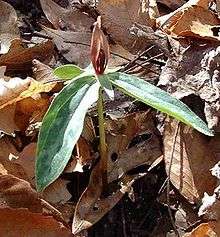Trillium lancifolium
| Lance-leaved trillium | |
|---|---|
 | |
| Gadsden County, Florida | |
| Scientific classification | |
| Kingdom: | Plantae |
| (unranked): | Angiosperms |
| (unranked): | Monocots |
| Order: | Liliales |
| Family: | Melanthiaceae |
| Genus: | Trillium |
| Species: | T. lancifolium |
| Binomial name | |
| Trillium lancifolium Raf., 1840 | |
| Synonyms[2] | |
| |
Trillium lancifolium, the lanceleaf wakerobin,[3] lance-leaved trillium or narrow-leaved trillium, is a species of plants native to the southeastern United States. It is known to occur in Alabama, Florida, Georgia, South Carolina, Tennessee and Mississippi.[4] The species has protected status as an endangered species in both Florida and Tennessee. Despite its overall rarity, it is locally common in places such as Steven's Creek Heritage Preserve.[5][6]
These plants are smaller than most other species in the genus, usually no more than 30 centimetres (12 in) tall, with comparatively inconspicuous flowers and leaves. As implied by both scientific and common names, the (lanceolate) leaves are notably narrow, about 2.5 times as long as they are broad, with the widest portion being more-or-less central. The petals are usually maroon or brownish-maroon, quite erect, and more slender than in most other species of Trillium.[5]
Trillium lancifolium blooms from February to May. It typically occurs in shady upland hardwood forests, but can be found in various other communities with some shade. Populations are usually scattered, and the individual plants are often present at low population levels.[5]
References
- ↑ "Trillium lancifolium". NatureServe Explorer. NatureServe. Retrieved 2008-05-02.
- ↑ Kew World Checklist of Selected Plant Families
- ↑ "Trillium lancifolium". Natural Resources Conservation Service PLANTS Database. USDA. Retrieved 15 December 2015.
- ↑ "Trillium lancifolium: Jones and Jones 4191 at MISS". Specimen at Pullen Herbarium, Department of Biology, University of Mississippi. Retrieved 9 February 2016.
- 1 2 3 Flora of North America Vol. 26 Page 111 Lance-leaved trillium Trillium lancifolium Rafinesque, Autik. Bot. 132. 1840.
- ↑ Biota of North America Program 2014 county distribution map
- Case, Frederick W.; Case, Roberta B. (1997). Trilliums. Timber Press. ISBN 0-88192-374-5.
External links
- Biodiversity Information Serving Our Nation (BISON) occurrence data and maps for Trillium lancifolium
- "Trillium lancifolium". Integrated Taxonomic Information System.
